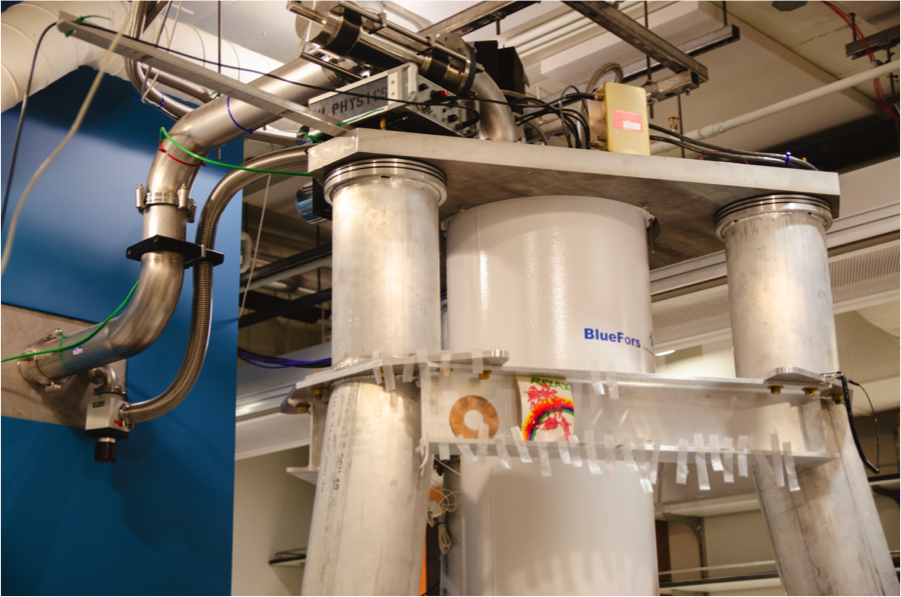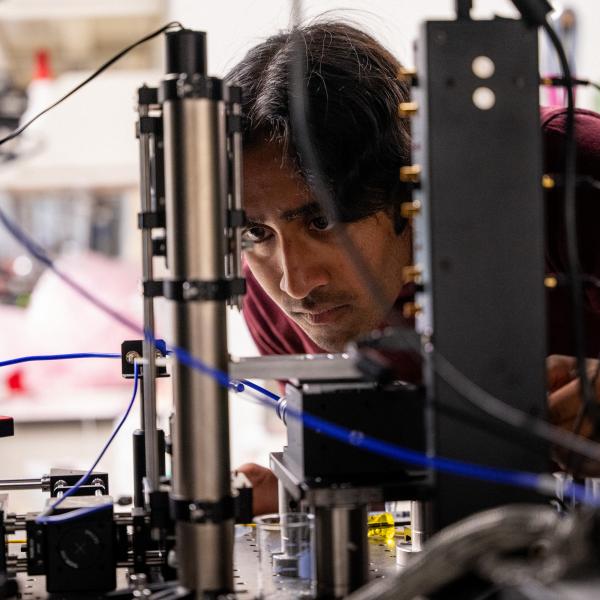Physicists in Arts & Sciences are unraveling the nature of elusive “two-dimensional” materials with an eye toward harnessing them for society’s benefit.
When you read the words “ruthenium trichloride,” you’ll either feel like falling asleep, reading on to satisfy your burning curiosity, or screaming into a pillow from chemistry class flashbacks. Those who choose the second option will be rewarded, because the molecule is fascinating. Erik Henriksen, a professor of physics, and his research group recently received a $406,000 grant from the National Science Foundation to study this molecule in its most fundamental form.

When sliced down to an extremely thin sheet of atoms, ruthenium trichloride acts as a two-dimensional material (all other materials you typically encounter are three-dimensional, having height, width, and depth). In this case “thin” means extremely thin – on the order of a few atoms thick. In bulk, the material exhibits properties associated with quantum spin liquids, which are poorly understood states of magnetic quantum matter. It is Henriksen’s hope that by thinning the material down to a layer that's only a few atoms thick, the strange magnetic properties associated with these quantum spin liquids will become more apparent.
It wasn’t until 2000 that hints of this quantum spin liquid behavior were first seen in the lab, after having been conjectured to exist in 1973, and it wasn’t until a 2015 study that they were associated with two-dimensional materials – specifically ruthenium trichloride – at Oak Ridge National Laboratory. After 15 years of studying graphene, another two-dimensional material, Henriksen knew he could put his expertise to use on this new branch of physics.
To understand quantum spin liquids, it’s important to understand the basis of magnetism. In typical three-dimensional materials, electrons are ordered “up” or “down” by their spin, or the direction their internal compass points. Most – those of the non-magnetic variety – have exactly as many electrons that spin one direction as electrons that spin the other direction. Magnetic materials have certain areas within their structure with electrons all spinning in the same direction, thus generating the force we know as magnetism. The magnetic nature of a material usually appears as it cools down, with the atoms and their constituent electrons ordering in a final state.
Quantum spin liquids are materials that don’t exhibit such order, even when cooled to near absolute zero. Instead, the electrons constantly fluctuate between different spin values, remaining in a liquid-like state with wave-like variations flowing across the sample. Ruthenium trichloride has already been shown to have these properties and Henriksen hopes that by slicing the material down to a few atom-thick layers these unique fluctuations can be isolated for intense scrutiny. Spotting these properties at quantum scales gives researchers insight into an exotic world of quantum phenomena that likely have real world implications.

To isolate these atom-thick sheets, the group utilizes a deceptively simple device: Scotch tape. “We’ve been using the same method for 15 years, and it still works well,” notes Henriksen. By sticking the desired material to Scotch tape and then proceeding to strip off successive layers with more tape – a process known as exfoliation – it’s possible to thin these materials down to nanometer-scale (one-billionth of a meter) thicknesses. After exfoliating successively smaller layers from the parent sample of ruthenium trichloride down to the two-dimensional realm, the resulting sample is sandwiched between two similarly thin sheets of boron nitride sitting on top of a silicon wafer for protection against contamination. This is what’s placed in the dilution refrigerator in the middle of the lab. It’s kind of like putting your ham sandwich in the fridge, if the sandwich were composed of atomically thin materials and the fridge were cooled to 10 milliKelvin.
Henriksen’s previous research on graphene gives his team a foundation upon which to study ruthenium trichloride. By putting both materials together in the atomically thin sandwich, the research group has already discovered something incredibly strange: Ruthenium trichloride, an insulator, conducts electricity when it interacts with graphene. This would be like observing electrical conduction in a piece of wood after placing it next to a steel rod. This mysterious behavior is an example of “emergent” phenomena, Henriksen notes. “It is somewhat akin to how waves in water aren’t predictable by studying single H2O molecules,” he said. “You have to have them all together and interacting to support waves, which are then ‘emergent’.”

These systems are known as many-body systems, an area of high interest in modern physics and one that is notoriously difficult to model. Here, “many” means anything over the number two. This seems like a low number, but one only needs to observe how quickly two pendulums swinging in tandem become chaotic to understand how difficult these systems are to model. Extrapolate this chaotic behavior to the actual number of interacting atoms in macroscopic objects – a human body has roughly 1027 atoms – and you get a problem that not even the fastest computers can solve without approximations. To get around this problem, Henriksen designs lab experiments to study the behavior of these systems. For ruthenium trichloride, the properties it exhibits such as electrical conduction, or the randomly ordered, fluctuating nature of its electrons, are a result of the many interactions taking place. So many in fact that, according to Henriksen, “They can’t be understood as arising from single-electron motion, but must be understood as ‘emergent’ properties of many interacting components.”
For now, the research group is focused on grasping the mysterious physics of ruthenium trichloride in its smallest form, but their long-term goals parallel something bigger stirring in physics labs everywhere. After the first quantum revolution computerized the world and spread its influence to every sector of technology, we are now entering a second revolution, which aims to fully manipulate quantum mechanics for our benefit. Handling the vast amounts of data currently zipping between continents, institutions, and mobile phones is becoming increasingly difficult, but understanding more about how quantum systems work means knowing how to process these immense amounts of information at unprecedented speeds. Just as magnetic materials underpin the fundamental components of our phones and computers, magnetic quantum spin liquids could have further, even more transformative uses. This basic idea means that Henriksen’s research could be fundamental to how humans solve problems in the future. The next big quantum revolution is happening as we speak, and Henriksen’s team is preparing us for it.





